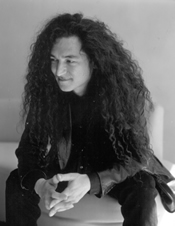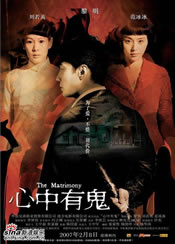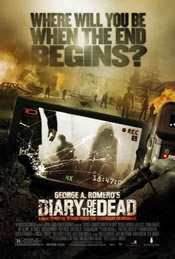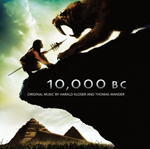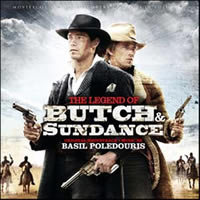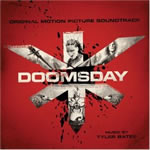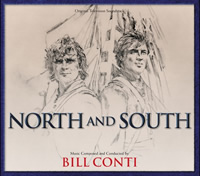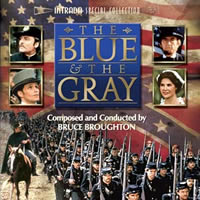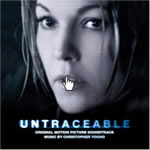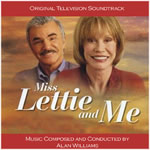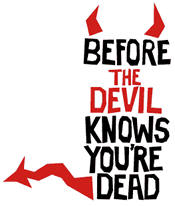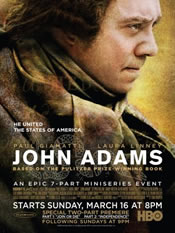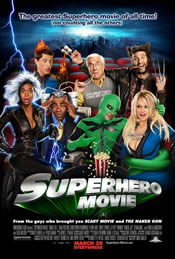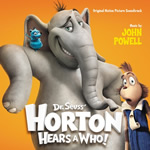 |
Diary of the Dead and other Horrors
March 10th, 2008By Randall D. Larson
This week we feature an interview with Norman Orenstein, whose new score, for George A. Romero’s latest Night of the Living Dead offshoot, Diary of the Dead, proffers a gripping aura of disturbiana for the shuffling reanimated deceased. Reviews this week include 10,000 BC, Doomsday, Untraceable, Cross Currents, North & South, The Blue & The Gray, Miss Lettie and Me, and Basil Poledouris’ final score, The Legend of Butch and Sundance. We also gather the latest roundup of notable film music news from around the globe.
Norman Orenstein Norman Orenstein’s Diary of the Dead
Toronto-based Norman Orenstein’s film music has meandered through the action film genre for the last fifteen years or so, after more than twenty years effort in performing rock and blues bands. Initially noted for his potent ambient scores for Robocop: Prime Directives and Cube 2: Hypercube, Orenstein has now made his mark in genre film music by scoring Diary of the Dead, George A. Romero’s latest excursion into the land of the reanimated deceased.
In Diary, Romero revisited with a fresh approach the potent mythology of the zombie that he single-handedly revitalized with 1968’s classic Night of the Living Dead, and which Romero continued to develop through Dawn, Day, and Land of the Dead. Diary now takes a new approach at the struggle between living and dead with a gaunt fistful of self-referential satire by depicting the story, Cloverfield/Blair Witch style, mostly through the cameras of a group of young film students who while filming a horror movie come face to sloughing face with real zombies.
Orenstein’s Diary music opens with a muted, beaten rhythm that really seems to speak of the massed and marching dead – while perhaps also reflecting their vacant heartbeats – while a plaintive and somewhat mournful woodwind figure intones somberly over a windy rush of synth tonalities. The score is brimful of eerie tonalities, percussive crashes, and sinewy strands of melody and harmony, while building a constant atmosphere of discomfort appropriate to the story’s necessary ambiance. Orenstein’s synth chords shuffle along with the slow cadence of the wandering dead, while more severe musical moments emphasize their famished rage and violence. Elsewhere a melancholic piano motif resonates amidst a harmonic haze of synth textures, and sirenlike wails echo through city walls above a pattern of rumbling electronic clusters and melodic phrasings.
Norman Orenstein started out as a guitar player, playing in blues, rock, and R&B bands in the 1970s. During the 1980's he co-founded a rock and soul band called Alta Moda which led to a deal with Epic Records, but about the same time he began writing music for television commercials. When Alta Moda appeared in an independent 1984 coming of age film called Unfinished Business, Orenstein was then asked to collaborate with Patricia Cullen on the film's score. He got the bug, and soon thereafter made film music his chosen career.
Prior to scoring Diary of the Dead last year, Orenstein composed the music for another pair of notable horror films, Matrimony, a Hong Kong ghost film about a newly married woman confronting the unforgiving presence of her husband’s former betrothed, and A Stir of Echoes 2: The Homecoming, a sequel loosely based on David Koepp’s 1999 ghost film in which, this time, an Iraq veteran returns home to encounter haunting visions of the dead. Interviewed last week, Orenstein described his experiences on these films and his perceptions of what contemporary horror film music is all about.
Q: How did you become involved in the Hong Kong film Matrimony (Xin Zhong You Gui) and what was most unique about this assignment for you?
Norman Orenstein: My work on this film began with the promotional trailer, which I scored, while the producers were still in the post production phase. The director was interested in using elements from that trailer music in the actual score of the film and from what I have seen and heard, they made excellent use of the various motifs, hits and ambient pads (extracted from the trailer). Despite the fact that the dialog was in Chinese, the trailer really had a fantastic look and feel and I was hooked. I learned that the story, a ghost love horror story, had to conform to certain rules laid down by the government of China. So because of a sensitivity to ghost stories, the script writers had to come up with some clever devices that I won't give away. Anyway, I was then asked to score some scenes as well. I have not yet seen the film in its entirety, but what I have seen is cinematically beautiful, and the original composer also provided some great music.
Q: What challenges did scoring this Chinese film pose to you in terms of logistics, composition, and recording?
Norman Orenstein: There were some language difficulties that came up, but nothing serious. There were also some revisions, which is understandable and not unusual. I composed and recorded as I always do, in my studio which is equipped with a combination of vintage analog gear and a computer based digital setup. The music stems were delivered via ftp and some elements were exchanged by courier. The post production team in China seemed to be quite savvy, a top notch group.
Q: Did the original composer's music affect what you wrote for these scenes - i.e., was there an attempt to be complementary to that music or its style?
Norman Orenstein: As I said, I have not yet seen the film in its entirety, but I did compose the "love recording" scene [Clip 1 at http://matrimony.hbpictures.com/english/media.htm - teaser trailer and trailer also feature Norman’s music] and a "love" montage. I understood that it was their desire to have this music be in distinct contrast to the rest of the score, so I did not reference the other composer.
Q: Stir Of Echoes 2: The Homecoming was an interesting horror film sequel with a contemporary anti-war message. How did the film’s multiple subtexts impact the music you wrote?
Norman Orenstein: The central character "Teddy" returns from service in Iraq, and carries with him the horrible experience of war. The events Teddy endured are the source of the horror. Ernie Barbarash (writer and director) has Teddy trying to get back to "normal" but the war has been changing America too, and these changes only trigger the recent memories, and Teddy is haunted by the ghosts of war. What I tried to do with the score was to support the patriotic good intentions while creeping around with unsettling and sometimes brutal jabs. Teddy is patriotic, trying to do the right things, but not all is resolved, and he ultimately "wants to make this right." The music has a faint Middle East tonality which comes and goes as the story twists along. To me the film is not primarily an anti-war film or just a horror film, it is really quite moral with irony and, in the end, tragic.
Q: What are the essential needs of music in a horror film? How does a composer invest his or her own voice into music designed to be, essentially, discomforting and uneasy?
Norman Orenstein: This is a tough question. There are certain conventions that are used, and they work. As the high strings crawl or the dissonance builds, the audience is somewhat educated to respond. It is a good thing that not all filmmakers are the same, so the contributing music is not always used with the same sensibilities. Sometimes the absence of music may be scarier to an audience, and then that silence gives the composer a great opportunity to strike (when moment demands). I find it actually easier to compose cues calling for discomfort and fear than music that taps more complex emotions.
Q: Do you have any specific techniques that tend to work well in accomplishing that?
Norman Orenstein: There are those conventions that all composers draw from. In most cases I think it is pretty obvious: thin veils of strings with creaking or intermittent pulses can add to the suspense, abrupt and loud events make you jump, discordant elements and melodies can writhe with horrific beauty. It has been pointed out to me that I can compose whole cues with minimal pitched content along with atonal and percussive sounds, very much in the vein of "sound design." I have many instruments here in my studio along with a growing collection of metal and organic objects that I can hit, bow, or throw at the wall.
Q: How did you get the job to score Diary Of The Dead?
Norman Orenstein: My good friend Michael Doherty brought me to the attention of George Romero and Peter Grunwald (producers). Michael is a superb editor and was deeply involved with the production of Diary of the Dead. I made a musical presentation and it clicked.
Q: What was it like working with George Romero, a director who has become legendary in the horror film as an innovative and influential auteur? How closely did he work with you on the scoring process?
Norman Orenstein: Working with George was a pleasure. George actually gave me a lot of room to work on my own. My initial discussions regarding the score were with Peter Grunwald, who as well as being a key business component in the project, was artistically entwined as well. They both understood that the music was essential to the film but not as a primary feature, that it was not to be the typical horror movie score. When George made his comments on the work in progress, the comments were incredibly succinct. I remember one instance where he said the cue was "too complex," and I knew exactly what he meant. Sometimes too much talk can actually cloud the point.
Q: How did the musical history associated with Romero’s Dead series impact what you were being asked to write for Diary?
Norman Orenstein: This musical history had no effect on the music I composed. This was to be a very different kind of movie and definitely different than what the previous "Dead" series had provided.
Q: When you first sat down to spot this film, what were your first impressions of what kind of music it needed, and how did that develop into the final score?
Norman Orenstein: As I have said, this was not to be a normal film. It is really a documentary film created by film students and the music was to be the music of that documentary. The producers were quite clear on that vision, and honestly, I never grasped the situation 100%, having to straddle the score for the "Diary of the Dead" movie and "The Death of Death" film all at once. George and Peter are not normal men.
Q What elements – thematic, motivic, or instrumental – are central to your DOTD score, and how have you developed them throughout the arc of the story and the breadth of the score?
Norman Orenstein: There is one cue used while the student filmmakers are shooting a scene for their "mummy" movie, and that cue is like traditional old school horror music. It reappears later in the film where action mimics that scene. The bulk of the score is horror type ambience with those strings and metallic bumps I have been taking about. There are montages and monologs where the music takes on more melodic and structured form.
Q: How would you describe your style of combining those sound-designish ambiances with acoustic instrumentation to generate an environment that is suspensefully effective while also interesting, musically?
Norman Orenstein: I've always liked creating sounds. I have some good microphones and I use them to record various instruments and objects. (Some sounds that are percussive in nature are created by hitting objects with various mallets or sticks, etc. Sustaining sounds can be created by using bows, mallets, or electric motors – even magnetism. I also use an old square piano as a resonator and for prepared piano effects, and guitars and other instruments as well.) For Diary of the Dead these created sounds were used in conjunction with orchestral instruments and then sent into the realm of digital audio manipulation. The sound design type elements are used create ambient backgrounds and for specific events while the traditional pitched instruments really provide the emotional power or environment, as you say.
Q: As a visual horror director, Romero has been known to push the envelope – and frequently tear the envelope wide open to reveal its steaming, seeping endtrails… As a composer, then, how do you score vivid and imaginatively graphic scenes of horrific gore in films like this?
Norman Orenstein: It is interesting that the film is a visual horror zombie event, but it's more than that. There are all these "Dead" references – including the Romero humor and the "shoot the zombie in the head" tradition – and it also references the technological communications era that we have today. While I meant to embellish the visceral experience, I also needed to be sensitive to the ideas George was putting forward. So the gore was not the only thing to keep in mind.
Q: Would you elaborate a bit on that? How did you musically reflect some of these other ideas George had in mind in the DOTD score.
Norman Orenstein: While there are "scare moments" that need to be hit musically, there is a tone to this film and I tried to play on that tone. I let the dialog and voice-over be king. So most of the score, I would say, is fairly understated, fading in and out as part of that environmental background. Sometimes there is a reflective tone for survival and loss of control, other times more traditional setup and payoff. The "media montages" have incoherent blips and kinetic streams of noises which is an obvious play on the massive amounts of information being communicated. I think that the mix of mutated electric guitar, synthetic and organic sound along with orchestral instrumentation sits well with the ideas George has on technology and humanity mixing and possibly spinning out of control.
Q: Diary, by depicting young filmmakers shooting a horror movie, seems to be almost a self-conscious commentary on Romero’s filmmaking process itself. Did any of this enter in to your discussions with the director or play into what you were doing musically?
Norman Orenstein: George has wrapped or maybe clustered together the ideas of filmmaking and the media, and truth and lies in this technological age. I think he is fascinated with the proliferation of video cameras, cell phone cameras, and the Myspace, Youtube generation, and the thought that while it is easier to communicate messages and images it is also easier to distort and falsify. This is all within a Romero zombie film about film students shooting zombies while making a mummy movie and posting their film bytes on the internet. I love it.
Q: What was most challenging for you about this assignment?
Norman Orenstein: There are always many challenges in scoring a film – the time deadlines, utilizing the available resources, and staying true to the producer's/director's vision. The biggest challenge for me was that balance between the score for "George A. Romero's Diary of the Dead" and the music in "The Death of Death" (that movie in the film...)
Q: How did the music for those two elements became integrated as those two facets merged in the film?
Norman Orenstein: This was the difficult part for me. The producers did not want the film "scored" traditionally, nor did they want it to sound as though the music was all "library music" edited in by the student filmmakers. I really went on feel, sort of going down the middle. As the score took shape, and was working for everyone, it became easier to just keep that vibe and let it be its own thing.
Q: Something I feel your scores for both DOTD and Stir of Echoes 2 do real well is exude a persuasive sonic atmosphere of claustrophobia, which seems to heighten the suspense and scariness of the music (and, subsequently, the film). Is there an intentional effort to musically isolate the listener and therefore make the listener/viewer feel more "at jeopardy" in horror film scoring and what is your technique in accomplishing this?
Norman Orenstein: That's an interesting question. It's not something that I consciously intended or rationalized. I take my direction, and I take from what I am seeing on the screen. There are so many great horror scores and I have learned from them, but I try to connect with the picture and give each film an original musical identity.
Q: Horror film music has obviously come a long way since the Gothic symphonic filigrees and cadences of the Universal horror films of the '30s. As a specialist in this genre, where do you see horror film music heading in the next dozen years or so, as technology continues to develop and this legacy of music for scary movies evolves around the next corner? How will styles, needs, techniques shift?
Norman Orenstein: Composers have access to that digital array of sound and music manipulation tools and the palette that it provides will evolve and expand. There are only 12 notes and those in between tones will be continue to be mined. The lines between music and sound design will continue to be blurred. In the end, it will always be the pitched compositions and melodies that carry the emotional muscle. I think that musical styles will shift in tandem with the style and substance of the films filmmakers create.
Q: What’s next up for you in film music? How do you top Diary Of The Dead on your filmography?
Norman Orenstein: I love "Diary of the Dead", and I think topping that would be "Diary of the Dead 2" if that were to ever happen. For now I'm entering the 5th season of Forensic Factor a show also known as Case Crackers. It's a crime re-enactment documentary series and totally different than "Diary of the Dead".
Remembering Leonard Rosenman
Leonard Rosenman, who received an Academy Award nomination Best Music, Original Score for Star Trek IV: The Voyage Home, died March 4th of a heart attack at the Motion Picture & Television Country House and Hospital in Woodland Hills, California. The composer, who won two Academy Awards and two Emmy Awards, was 83 years old. He was known for a more modern style of composition than many of his predecessors in Hollywood, and contributed notable scores to all manner of films, including East of Eden, Rebel Without a Cause, Fantastic Voyage, Beneath (and Battle of) the Planet of the Apes, and the Ralph Bakshi animated (read: rotoscoped) version of The Lord of the Rings. He won Oscars for his music for Barry Lyndon and Bound for Glory.
For a very good retrospective of his life written by Jon Burlingame for the Film Music Society web site, see: http://filmmusicsociety.org/news_events/features/2008/030408.html
I have also had my 1987 interview with Rosenman, centering around Star Trek IV, posted on the CinemaScore archives web site, at:www.runmovies.be/index.php?option=com_content&task=view&id=500&Itemid=159
This Week's Recommendations
Decca Records has released the soundtrack for this week’s prehistoric epic, 10,000 BC, on both cd and digital download from iTunes. The music is a collaboration between Harald Kloser (The Day After Tomorrow, Alien vs. Predator; he’s also credited as an exec producer and writer on 10,000 BC) and Thomas Wander (aka Thomas Wanker; frequent collaborator with Kloser who also scored numerous late-season episodes of Buffy). The music is elegantly primitive, with pounding drums and gutturally chanted vocals sounding as BC-historic as you might imagine, overlaid with the kind of poignant, slow-moving melodies that Kloser has been known for from his previous scores. “Speech,” for example, is a terrific combination of both the primitive and the passionate, with a languid, lyrical melody line from massed strings swaying like windblown palm leaves while below a massive torrent of awakening life moves in tremendous savagery and violence. “Mannak [mammoth] Hunt” is a furious pounding of drums and massive feet and hungry, male changing, roaring woodwinds and aggressive shouts of brass, sprinting strokes of violins racing to a bloody climax. Hushed violins and [sampled?] choir set a softer cadence for the introspective “I Was Not Brave” and the later “Wounded Hunter,” while the hero finds sure vindication in “Lead Them,” which opens into a glorious melody for ascending and quietly victorious horns and strings, as hopeful a motif as 12,008 years ago could aspire to. “Night of the Tiger” and “Terror Birds” are splendid action pieces, a frenzy of percussion and shotgun orchestral measures; “Food” is all aboriginal chanting over shakers and toms; “Wise Man” is an ambient mysterioso, very persuasive and intriguing. “Sea of Sand,” like “Lead Them,” is a glorious and captivating variation of the heroic main theme for horns and strings, echoed by choir (probably sampled but effectively so). The music has a rich and provocative sound, and the mixture of primitive percussiveness and eloquent elegance from a richly textured orchestral palette is very attractive. I really like Kloser’s work, and reviewing Wander’s filmography reveals that he’s worked on almost all of the former’s scores, so the 10,000 BC music is very much of a piece with what we’ve come to like about Kloser, while venturing into somewhat more unrefined musical turf.
MovieScore Media has resurrected a lost basil Poledouris score – his final composition prior to his untimely death in 2006. The Legend of Butch and Sundance was a 2003 TV movie recently released on DVD. The film, purporting to tell the “true” story of the legendary outlaws popularized in the 1969 George Roy Hill movie, stars David Rogers and Ryan Browning, and was directed by Sergio Mimica-Gezzan, a protegé of Steven Spielberg. The music forThe Legend of Butch and Sundance is, as always with Basil’s music, a rich one derived from folk music sensibility: it features a spirited main theme, rhythmic suspense and action music, Mexican-flavored tunes, and a beautiful love theme. The music was scored for an ensemble of solo instruments including guitar, mandolin, accordion, cello and violin, and made subtle use of sampled orchestral instruments. It’s a more intimate score than the composer’s Western music for Lonesome Dove or Quigley Down Under, but it’s equally sublime and energetic in its places. Poledouris’ use of flamenco guitar as an action motive is especially intriguing: “Church Robbery” makes a captivating flamenco and marimba dance out of what would otherwise would have been a standard action cue. The Mexican guitars are associated with the Latin American landscape and culture in which the outlaws spent most of their latter years, but they also suggest the free spirit embodied by Butch and Sundance in these closing wild west days. “First Robbery” provides a cool accordion rhythm on top of the acoustic guitars with a really nice reverberated percussion underbelly that drives the cue (the accordion taking the place of synths in a kind of hybrid action music timbre); and then the cue explodes with an energetic fiddle playing a really nice folksy melody (ala Charlie Daniels at his most frantic) over drums and strummed guitar as the robbers make their getaway. “No Drinking With A Coward” explores the film’s main theme, a 5-note descending guitar measure that isn’t quite heroic nor quite villainous; “First Kill” reprises the theme by fiddle over strummed Italian-Western styled guitar and distant, echoed rumbles of drum punctuated by maracas. “Third Robbery” is a more self-assured, confident, even arrogant rendition of what had been more furtive and nervous in “First Robbery.” “Sunrise Bonding” is a poignant cue for violin, guitar, and mandolin as the outlaws discover their business partnership; “What Could Happen?” is another introspective track illustrating the rapport of the outlaws as they interact with friendship and partnership in between their acts of violence and theft; the music bolsters their heroic honor embodied even by these self-serving outlaws. “Pinkertons Attack/Mike Shot” is a terrific and very Poledourisian track for ascending synth melody that blossoms dramatically and beautifully out of the incidental dalliance of guitar and violins that open the track. “Getting Horses” features another splendid and lively melody from fiddles over drums and guitar; the fiddles interplay nicely with mandolin, guitar, and accordion in “Pinkertons Arrive at Train.” A descending glissando of low bass guitar notes reverberate strikingly in “Price of Being an Outlaw,” interacting dolefully with (sampled?) flutes and guitar. The composer’s musical texture is rich, homespun, and provocative throughout the whole score, with “Finale,” the hyper dramatic “Wyoming,” and “Two Weddings: End Credits” especially provocative closers for the album.
Lakeshore Records will release Tyler Bates’ evocative soundtrack for Doomsday on March 18th. This new thriller from writer/director Neil Marshall (The Descent, Dog Soldiers), authorities brutally quarantine an area of England as it succumbs to fear and chaos when a virus strikes (not unlike elements of 28 Days Later). The literal walling-off works for three decades--until the dreaded Reaper virus violently resurfaces in a major city. An elite group of specialists, captained by Eden Sinclair (Rhona Mitra), is urgently dispatched into the still-quarantined country to retrieve a cure by any means necessary. Shut off from the rest of the world, the unit must battle through a landscape that has become a waking nightmare. With more than forty film and TV scores to his credit, Tyler Bates’ inventive style has become associated with projects like Rob Zombie’s Halloween, The Devil’s Rejects, and the upcoming release of the animated feature The Haunted World Of El Superbeasto. Bates also composed for director Zack Snyder’s blockbuster hits 300 and Dawn Of The Dead. Bates continues to score Showtime’s dark comedy Californication (starring David Duchovney). His 2008 projects include two major films to be released later this year, Watchmen (directed by Zack Snyder) and The Day the Earth Stood Still (a remake of the 1951 sci-fi classic).
Which brings us to Doomsday. If you thought 300 was a massively impressive cinematic composition, well, you ain’t heard nothin’ yet. Bates’ music for Doomsday, presented on CD via 20 tracks sandwiched between a trio of songs (Adam and the Ants, Frankie Goes to Hollywood, and Ariel Rechshaid’s techno remix of “The Can Can”), is an outstanding hybrid of orchestra and synth but it’s nothing like what you’d expect from the “traditional” hybrid scores that you’ve heard before. It’s epic and huge and yet it’s also thin and synthy; Bates keeps his synths and his symphs as a distance from one another, and allows each to craft its own musical environment and attitude. While the score finds plenty of room for large scale orchestra, Bates also scores many scenes for synthesizers alone – some tracks, like the poignant “Piss and Vinegar,” are the kind of tracks we heard back in the 80s when somebody’s moog or synclavier that was all we had for musical accompaniment and nary an acoustic instrument was anywhere near the soundtrack. Bates’ provides a neat bit of archaic nostalgia for that musical environment with these tracks, which work very well in creating a, now, unusual mood in distinct contrast with the thicker orchestral pieces. “Exodus” is a stirring, purely orchestra and choir, a massively affecting opening musical composition (after being introduced by the ambient synthesis of “Prologue”), as Bates’ builds up a tremendous rhythmic cadence that is rich in empathy and regretful purpose. “Captured” embodies a similar orchestral front, laced with curious female vocal intonations. In “Prime Suicide” portrays its melancholy orchestral measures over a thick rumbling of drums and, deep in the mix, a low synth pad. Bates brings out all the electronics for “Boat,” which is thoroughly synth driven cue, all very metallic and synthy, the textural antithesis of “Exodus’s” pure acoustic sensibility. “Sinclair Slips Free” and “Train Escape” are both a heavy rhythmic action tracks for electronics, guitars, and drum kit. “Bentley Escape” is a thoroughly thrilling track merging together all the elements that have gone before, heavy orchestral surges, soaring horn ascensions driven by cyclonic swirling arpeggios of violins, barrages of synths, crystal clear electronic guitar soloing over female choir and solo voice, thunderous drumming, burbling pads of electronic textures; one of Bates’ most compelling and interesting compositions to date. All of Doomsday is really very appealing and attention-grabbing. It’s calculated textures and orchestration is inventive and exciting, the score’s musical integrity shining through at even its most chaotically dissonant. More evidence that Tyler Bates is by far a composer to be reckoned with.
FSM has released an ambitious 8-CD box set collecting all of the music for the Superman franchise of the 1970s and ‘80s, from John Williams seminal and signature music for Richard Donner’s Superman: The Movie, through its three sequels and onto its life as an animated series on TV. All of the music is drawn from Williams’ 1978 themes; adapted by Ken Thorne into the scores of Superman II (1980) and Superman III (1983), by Star Trek’s Alexander Courage into Superman IV: The Quest for Peace (1987), and by Star Trek: TNG’s Ron Jones into the animated show (1988). The eighth CD contains a plethora of alternate tracks from the first three Superman movies and a fistful of very dispensable disco songs written by Giorgio Moroder for use in the latter movies. The 8-disc set is thorough to the point of overindulgence; but for those eager to savor every second of soundtrack music, it may well be a boon. John Williams’ original score is well represented on the soundtrack market, most recently with a 2000 double-disc reissue from Warner Bros (35 tracks total with 2 hr 27 mins of music; FSM provides 37 tracks and 2hrs 26 mins of music; the Warner Bros DVD release of the movie 2001 included 7 tracks of outtakes, not all of which appear to be included on FSM’s 8th disc). Ken Thorne’s music from Superman II was released on LP in 1980 (15 track), but only on CD in Japan in 1990, pairing it on a single disc with music from the unreleased score from Superman III (8 tracks + 4 pop songs)’ the Courage and Ron Jones material makes its album debut on the FSM set. The music is all great, but even at its best there’s almost too much of it, only too many variants on Williams’ Superman Theme and Love theme; the best new material is that of Courage and Jones when they are composing their own action material more removed from the overly familiar caped crusader’s material. But it’s a noble and very definitive set and recommended for those like me who must have it all. A very thorough cd-sized 160-page hardback book analyzes the films, the music, and the CD tracks in voluminous detail.
Along the same lines is the Varese CD club release of Bill Conti’s splendid and Emmy-nominated score from the epic 1985 TV Civil War miniseries, North and South. Headlining last month’s limited edition releases, North and South is presented as a 4-disc box set, and is the premiere release of the 6-part miniseries’ original soundtrack. Varese had earlier released a 7-track Symphonic Suite, paired with the same from Conti’s wonderful The Right Stuff (another score that cries out for a true complete original soundtrack release) totaling a mere 37 minutes for the both of them; the new CD Club edition gives us a walloping 4+ hours of music (including the fourth disc’s rather inconsequential compilation of traditional and source cues uses in the film). But it’s the score music that’s most interesting, of course, and that is spread across three discs, two episodes per disc. The 9.5 hour miniseries needed a lot of music, which meant a lot of theme and variation, and that’s mainly what we have here, so expect a lot of repetition of the primary themes across the three CDs. While the Symphonic Suite (nicely performed by the London Symphony Orchestra, conducted by Conti himself; the orchestra that performed the original soundtrack is not identified and is mostly likely a [very capable] studio ensemble). Conti’s main theme is a rich, lyrical, and very memorable theme, resonating from north to south and representing the whole sweep of this significant era in America’s history; subordinate motifs represent the various characters populating either side in the struggle. The action music is largely derived from the thematic material, and all of it is well crafted, tonal, rhythmic, and melodic in sensibility, with occasional a very minor hints of traditional and folk tunes of the period. It’s a grand and very eloquent score, a stupendous work that Conti rightly considers to be one his finest achievements, and it’s well worth finally having a proper, if almost too hefty, a soundtrack package. A 20-page booklet with notes by Julie Kurgo, examining the film and the music in general terms, accompanies the CD set.
Also very grand and eloquent is Bruce Broughton’s previous Civil War magnum opus, The Blue and the Gray. This 1982 miniseries was television’s first large scale examination of the Civil War, and was the composer’s first big score, after eight years scoring episodic TV and the occasional TVM. After waiting for this score to receive a proper release for more than 20 years I am extremely grateful to Intrada for issuing it as their 57th Special Collection volume in a 2-CD limited edition of 2,000 copies; their latest release in their ongoing support of this composer. Broughton’s score for The Blue and the Gray is instantly captivating thanks to one of my all-time favorite main themes; opening militaristically with bugles and snares but then segues into a magnificent melody for strings that captures in a profound way the passion and pathos of the Civil War and its participants; with sweeping grace and a potent dramatic lyric, the main theme embodies a fairly complicated melody line that ascends in several recurrent measures that is able to characterize both the epic struggle of the war itself and the more intimate struggle of the family fighting on opposite sides of that struggle that the miniseries focuses upon. Intrada’s 2-disc CD, like that of its Varese Sarabande cousin of wider girth from North and South, also contains a substantial amount of theme and variation in its 2-hour+ running time. Broughton’s score is perhaps a little edgier and more modernistic than Conti’s elegant North and South, although both are thoroughly effective and appealing on their own. But Broughton’s unusual main theme has grabbed me like no other. FSM’s John Takis provides thorough notes on the creation of the score and a track-by-track commentary in the 20-page CD booklet.
Christopher Young’s mysterious and haunting score for the Diane Land thriller, Untraceable, has been released by Lakeshore Records. Emphasizing a main theme for piano over strings, Young evokes a marvelous sense of brooding mysterioso and unease with this most tonal of approaches. The score, represented on CD by eleven tracks ranging from a little over 2 minutes to 6 ½ minutes, sustains an ongoing mood of hidden menace, elevating the film’s tension parameter by several degrees. Young leaves the warmer tonality of the piano for the film’s opening and closing, emphasizing harsher, darker, and less benevolent tonalities for the music’s primary attitude. It’s a very ambient score; aside from that opening theme which we will hear again at the denouement, a few textural motifs and figures recur from time to time, but the overall approach is one of sustained atmosphere and apprehension. The score proceeds slowly and deliberately, emerging its sound design by small measures that gradually increase the score’s sonic tension; it’s a multi-layered fabric of harmonic fog, a sonic mist that weighs heavily upon the film and keeps the viewer continually unsettled; on CD the score is appealing for its intriguing textures and rhythms, tracks like “Viewer Executioners” construct a solid organic framework of sound through which Young’s fluid strains can flow, evoking shifting moods of menace, foreboding, concern, while bolstered by a confident forward movement and direction. Young’s Untraceable is purposeful music, building to an end even while appearing deceptively ambivalent along the way; the film is about control – specifically, an unknown serial killer gaining increasing [and unbelievable] control over all aspects of an FBI investigator’s life; the music mimics that control by both emphasizing the agent’s escalating lack of control while it does so with very carefully controlled musical rhythms, textures, and direction. Developed sounds and samples enhance the score’s sonic pallet, “Blinking the Code” merges an industrial sounding synth tenor with an increasingly agitato violin pattern, each growing with heightened alarm as the cue progresses, finally culminating in a brilliant, undulating, low roaring moan as if all the film’s dark and gloomy answers had spilled out onto the floor of the recording stage, resolved only by a sudden respite of bright, crystal tones of horns and piano and a shimmering clarity of high-end synth. This is an amazing cue, a resplendent example of growing horror and darkness, uniformly kept in check by tightly controlled sound design and performance; a birth canal-like experience of musically moving from confinement and darkness into rescue and warmth, from manipulation and loss of control into understanding and self assuredness. That the music can evoke this kind of interpretation even apart from the film is fairly remarkable; Young has successfully captured the film’s underlying tonalities and subtexts into his music, which both drives and supports them. The final cue reprises the opening theme, the film, score, and character growth having evidently come full circle.
One thing about Italian film music, if I may segue from one West to another, is that the country’s film music of the 60s and 70s contained some of the coolest theme songs. Non-Sergio Leone westerns and the ubiquitous Eurospy thrillers that were spawned from Cinecitta and other studios during the late 60s and early 70s almost all contained a main or end title theme song, often drawn from the era’s pop and rock sensibilities. The best songs from Bruno Nicolai’s film scores have been collected in Bruno Nicolai: Movie Songs Book by Edizioni Musicala Gemelli of Italy. From the compellingly dramatic “Ringo Come To Fight” from 100,000 Dollari per Ringo (provided in both English and Italian vocal versions) to the far more amusing “Arizona Gun” from Arizona Si Scateno' E Li Fece Fuori Tutti (1970) with its halfhearted lyric (I guess I gotta get my gun/I guess I gotta shoot someone/Bang Bang!) and such Goldfingerish spy songs as “”I Want It All” from Femmine Insaziabili (1969, The Insatiables; also sung in both English and Italian) and the classic “Love Love Bang Bang” from Kiss Kiss Bang Bang (the 1966 Italian film, not the 2005 Shane Black thriller), not to mention “Shadows” from the giallo thriller, Le Coda Della Scorpione (Case of the Scorpion’s Tail), this compilation is a very enjoyable collection of 60s era pop tunes with their own unique cinematic dramatic sensibilities. Singers include Edda Dell’Orso (which automatically makes this CD a must-have in my book; she sings the title theme from 1975’s Allora il Treno, a really nice jazzy score otherwise unavailable on CD; issued only on LP in Italy), Fred Bongusto, actor Tomas Milian, and Bobby Solo, with choir by I Cantora Moderni di Alessandroni (the vibrant choral “Libertad” from Uomo Avvisato Mezzo Ammazzato Parola Di Spirito Santo – 1971 aka Blazing Guns, aka His Name Was Holy Ghost; one of Nicolai’s neatest Western scores). There are a couple of blushworthy tunes, to my tastes best left forgotten (“Go-Giddy-Go” from Land Raiders [the haunting “Sweet Love Song” from the same film, which adopts the main theme’s melody, is a much much better song, also included on the CD] and the carnivalistic “Gamba Gamba” and “La-Lu-Le” from the otherwise excellent Zenabel), but the collection is an excellent and very likable one.
Miss Lettie and Me is the latest promotional soundtrack issued by Alan Williams’ private label, Silverscreen Music. The film was a 2002 Turner Network TV drama significant mostly in pairing Burt Reynolds with Mary Tyler Moore (returning to the small screen for the first time in years) as a estranged couple brought back together over the holidays by their feisty young niece who visits the aging woman’s isolated farm. Williams’ music is everything you would expect from a heartfelt television drama like this – and it’s wonderful because of it. Comprising two dozen mostly short cues featuring folk instruments like steel and nylon guitars, mandolin, flute, oboe, clarinet, and piano (performed by the composer), the score is intimate and poignant, embodying the distant characters with true emotions and drawing them together musically much as the young child does in the film. “You Watch Over Things,” in which the score’s main theme becomes a hymnlike soliloquy for piano and guitar, is a musical moment to be treasured; its reprisal in “Tallulah is Gone” is similarly affecting. The closeness and quiet poise of Williams’ instrumental ensemble accentuates the film’s already evocative immediacy and heightens the film’s cool drama and its moments of joy (“Thanksgiving Dinner,” for example) with the serene harmonies and gentle tones of the guitars and piano. The pallet also gives substance to the film’s rural setting, recalling its environment even while the film itself remains fairly close indoors. Alan Williams’ penchant for evoking the innermost feelings of his characters, bolstering the screen performances with lyrical nuances of melody and timbre and accent, is made for films like this, and it’s very pleasing to see a score like this not left forgotten.
Fin de Siecle’s latest release comprises George Gaslini’s excellent score for Tonino Ricci’s 1971 giallo thriller, Un Omicidio Perfetto A Termine Di Legge (A Perfect Murder in Terms of the Law – better known more simply as Cross Current), pairing the original 13 Cinevox LP tracks (and a source music inedit culled from another Cinevox compilation) with 15 previously unreleased previously tracks, including the film’s pop-toned title song (sung by an unidentified [for good reason] male studio singer) and its much more appealing and brassy end title cue. The score features the incomparable voice of Edda dell’Orso (see my comments previously – although be warned, most of her singing here is of the kind of quasi-orgasmic female moaning and guttural intonations that Morricone was known for in his scores for Argento and others.), and Gaslini’s main theme is as richly melodic as most giallo scores tend to be, playing against their horrific visual counterparts with lushly lyrical tunes and themes. The scarier aspects of the film are emphasized in tracks like “Brividi Di Paura,” a chilling sustainment of harsh high-end strings and free-form percussion raps and rumbles. In tracks like “Barlumi Di memoria,” dell’Orso cries and warbles beautifully, evoking sympathy for the victims of Ricci’s cruel murderer. “Darsena Fatale” is a dissonant track for increasingly-beaten drums over dell’Orso sustained, tortured intonations, while extremely rapid harpsichord fingering tends a claustrophobic disturbance to “Un Uomo Solo.” “Ritorno Sospeso” proffers some neat suspenseful sound design, from closely-miked metallic scraped and percussive raps and taps, clear bell tones, jangling chains, and low, hollow-ish clarinet, opening into a rhythmic motif. “La Fuga” takes the previous harpsichord fingering and plays is on piano, accompanied by electric bass and furiously pumped bongos, building a claustrophobic miasma of sound that is as compellingly interesting as it is unnerving. The previously unreleased tracks contained a number of very interesting variants on the suspense motifs (“”Tentazione Bianca #2” being an especially evocative mysterioso comprising flute, violin, and harp). John Bender provides informative notes about the film and its score; the release comes in a trifold digipak.
Film Score News
Kristopher Carter, Michael McCuiston and Lolita Ritmanis, the composer team also known as Dynamic Music Partners, are currently working on the music for Sony's new animated TV show The Spectacular Spider-Man, focusing on the 16-year-old Peter Parker and the origins of Spider-Man. The cast includes Josh Keaton doing the voice of Parker/Spider-Man, and Peter MacNicol doing Doc Ock. The first episode, "Survival of the Fittest," premiered on March 8. Carter, McCuiston and Ritmanis - whose previous credits include Justice League and Teen Titans - are also scoring the new action series Ben 10: Alien Force for Cartoon Network. – via upcomingfilmscores.com
Christopher Young adds to an impressive list of nearly 100 feature films in virtually every genre with the score to Sleepwalking, a new drama stars Charlize Theron (who was also involved as a producer on the film), Nick Stahl, AnnaSophia Robb, Dennis Hopper, and Woody Harrelson. Sleepwalking premiered at the 2008 Sundance Film Festival and is scheduled to open nationally on March 14; the film tells the story of James Reedy (Stahl), a simple man who leads a less than ordinary existence. When his sister Joleen (Theron) seemingly abandons her daughter Tara (Robb) with him, Reedy steals away with the girl and takes to the road.
Carter Burwell provided a replacement score for Sidney Lumet’s 2007 thriller, Before the Devil Knows Your Dead. No soundtrack album was released, but Burwell has posted four mp3 sample files on his website for those who want to have a listen. See: www.carterburwell.com/projects/Before_The_Devil.html#Film_Info
For a perceptive review of the music as heard in the film, see: www.moviemusicuk.us/btdkyd.htmComedy specialist George S. Clinton (teams up again with Mike 'Austin Powers' Myers, scoring his new film The Love Guru, which will be released in theatres by Paramount on June 20. Clinton scored all three Austin Powers movies. Myers stars as Pitka, who was raised by gurus abroad and returns to the US attempting to break into the self-help business. Jessica Alba, Justin Timberlake, Jessica Simpson and Ben Kingsley co-star. George S. Clinton also has Harold & Kumar Escape from Guantanamo Bay on his list of upcoming films. – via upcomingfilmscores.com
Rob Lane and Joseph Vitarelli provide the music for the ambitious new HBO historical miniseries, John Adams, based on the acclaimed biography by David McCullough. Paul Giamatti stars in an excellent casting choice as America’s second president, with Laura Linney as wife Abigail. The show premieres on HBO on March 16th.
If you like Italian film music (Westerns, Eurohorror, Italian Police thrillers and political dramas) you might want to know about a new online discussion group called Movie Music Italiano, managed by noted film music journalist and interviewer John Mansell. MMI began its life as a discussion group on Yahoo. This group grew and the next step was to create a web site. This site is dedicated to the discussion, promotion and enjoyment of Italian and European film music. It also contains items that are related to all forms of film music. Join up at: www.freewebs.com/moviemusicitaliano/
Laura Karpman is writing the score for Ace Ventura 3, aka Ace Ventura Pet Detective Jr, directed by David Mickey Evans. In this sequel, the son of the eccentric detective known from the first two films in the series, steps into his father's shoes. Josh Flitter stars as the young detective, and other cast members include Chris Adler and Ann Cusack. Karpman previously scored The Sandlot 2 for Evans. Her other recent films include Man in the Chair and Out at the Wedding. She is best known for her score for the sci-fi tv series Taken and the video game scores Everquest II and Untold Legends: Dark Kingdom.
– via upcomingfilmscores.com
Superhero Movie, the new spoof making fun of films such as Spider-Man, The Fantastic Four and X-Men, gets an original score by James L. Venable. The film is directed by Craig Mazin, who wrote the screenplays for Scary Movie 3 and Scary Movie 4, both of them scored by Venable.
– via upcomingfilmscores.com
Soundtrack News
Perseverance Records has released The Film Music of Jim Manzie, Vol.2, a second collection of music from this underrated composer of genre movies. This CD features selections from Sleepstalker: The Sandman's Last Rites, Bowling Balls - Insane Clown Posse, Scarecrow, Servants of Twilight, Stepfather 2, Red Blooded American Girl, Night of the Demons 2, From a Whisper to a Scream and Moonrise aka My Grandfather is a Vampire. Like Volume 1, this compilation features notes by Jim and the directors he has worked with on the various projects that give insight into the scoring process and the collaboration between director and composer. Filled with artwork, this promotional CD is limited to only 250 pressings. See: www.perseverancerecords.com
New releases announced by Perseverance include Mutant by Richard Band (March – an expanded version with 7 bonus Main Titles from other Richard Band movies), The Interior by Edwin Wendler (April – the label’s first downloadable only score from the Internet show – see </www.TheInterior.tv>), Knightriders by Donald Rubinstein (May - the cult soundtrack to George A. Romero's 1981 motorcycles & javelins sci-fi classic), and The Runestone by David Newman (July - arguably the best horror score by this fine composer, according to Perseverance).
Varese Sarabande will release John Powell’s score to Horton Hears a Who on March 25th. Powell’s far different score for the gritty action thriller, Stop-Loss, appears the same day. Randy Newman’s score for the sports comedy Leatherheads also will be released the same date. George Fenton’s score for the Matthew McConaughey/Kate Hudson romantic adventure Fool’s Gold precedes them on March 11th,
CAM Original Soundtracks of Italy has released the original score for Hotel Meina, composed by Luis Enriquez Bakalov. The war film tells the story of how the Germans may react to the armistice of the 8th of September 1943, when Italy betrays them and joins sides with the allied forces - the film centers around a group of 16 Italian-Greek Jews evacuated at The Meina Hotel who wonder just how the Nazi’s will respond to this development. This and CAM’s other recent releases are available for download on iTunes.
The University of Illinois Press, in conjunction with New York University Steinhardt School's Department of Music & Performing Arts Professions and The Film Music Society, has published Music and the Moving Image, a premiere online scholarly journal dedicated to the relationship between music and the wide spectrum of moving images, from film and television to computer and interactive performance. Music and the Moving Image will be issued three times annually (Spring, Summer, Fall). Issue No. 1 (Spring 2008) will receive its inaugural launch on February 29 at http://mmi.press.uiuc.edu/. Annual individual subscriptions are available for $30 (members of the Film Music Society are allowed a rate of $21). An order form is available at http://www.filmmusicsociety.org/news_events/features/pdfs/MMI_order_form.pdf
Intrada has released the soundtrack from Brett A. Hart desert thriller, Bone Dry, starring with Luke Goss, Lance Henriksen and Dee Wallace. Scott Glasgow ‘s score emphasizes the film’s brittle, arid landscape with a complex series of motifs that evolve from the environment portrayed on screen: sounds of "plucked cactus" and other brushed and scraped colors all play role in dramatic tone poem. As longer ideas unwind, smaller motifs emerge within. Harmonic vernacular is sparse, challenging. Final three movements played by FILMharmonic Orchestra of Prague add further weight, forming the substantial 15-minute "Retribution Symphony."
Interlude & Rapture and Music for the films of Jack Clayton, two previous releases of Georges Delerue music arranged by Robert Lafond are available again from Canada’s Disques CinéMusique. The musical content is unchanged but inserts have been improved, especially for Interlude & Rapture which 20-page booklet includes many additional stills.
www.disquescinemusique.comNew Line Records has released the soundtrack to Love in the Time of Colera, featuring a score by Antonio Pinto along with various songs.
Randall Larson was for many years senior editor for Soundtrack Magazine, publisher of CinemaScore: The Film Music Journal, and a film music columnist for Cinefantastique magazine. A specialist on horror film music, he is the author of Musique Fantastique: A Survey of Film Music from the Fantastic Cinema and Music From the House of Hammer. He now reviews soundtracks for Music from the Movies, Cemetery Dance magazine, and writes for Film Music Magazine and others.

